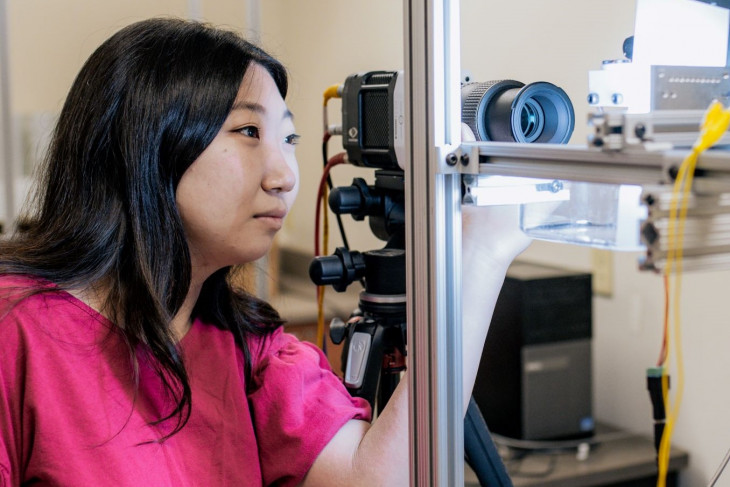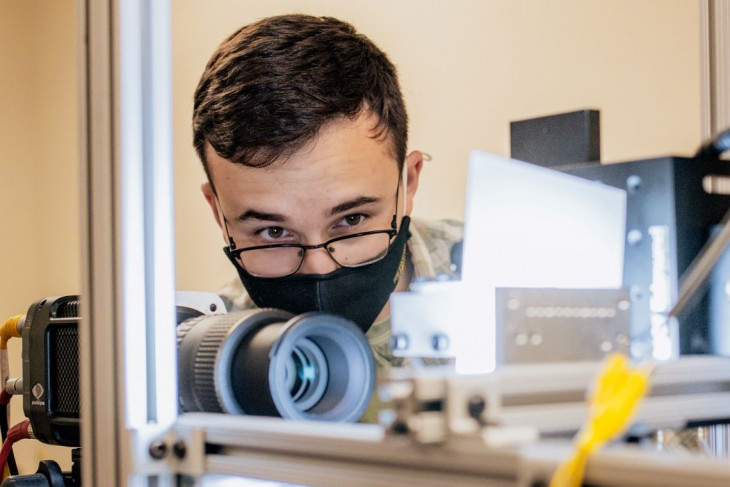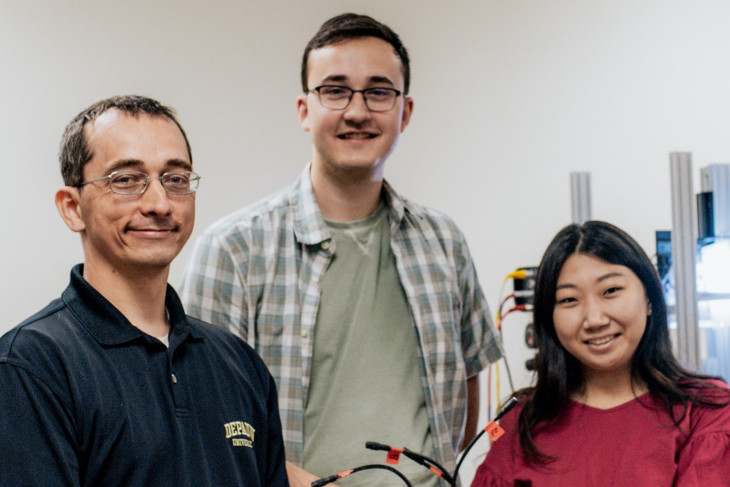Two DePauw University physics students who set out last summer to resolve what had become “an annoyance” in their professor’s physics lab ended up creating a device that simplified their work and will be accessible to research labs anywhere.
Nanami Mezaki ’23 and Ben Wilkerson ’24, like other students who previously conducted research led by Jacob Hale, associate professor of physics and astronomy, were studying noncoalescence – the phenomenon in which a droplet of water hits the surface of a pool of water but does not merge with it.
Mezaki, a pre-engineering major, and Wilkerson, a computer science major, knew that that the size and shape of a droplet, its speed and angle and its occasional production of a satellite droplet affect the original droplet’s performance in the pool.
So they went looking for a way to create droplets that were more uniform in size and shape and that did not create a satellite. The need to identify a way to do so has been “an annoyance” in Hale’s laboratory and a question whose answer “just wasn’t as exciting,” he said, as other aspects of the research he and his students have been conducting for 10 years. The research has resulted in publication of two papers.

Nanami Mezaki ’23

Ben Wilkerson ’24

Jacob Hale and students
The behavior of fluid droplets is important in some industrial settings, such as the manufacture of coated camera lenses and the performance of combustion engines, and the problem of noncoalescence is an active field of study far beyond DePauw.
And in fact, droplet-on-demand devices have been built elsewhere to resolve the same issues the DePauw researchers had. Hale and his students found an open-access engineering plan created by a Brown University professor and went about replicating it.
Only the Brown professor’s plan requires a more sophisticated 3D printer than DePauw owns. And the device it produces requires cost-prohibitive, machine-tooled nozzles to work. And DePauw’s 3D printer was on the fritz.
Mezaki and Wilkerson, with Hale’s assistance, borrowed the 3D printer from the Tenzer Technology Center, fixed it, modified the Brown design to work with DePauw’s printer and addressed issues such as temperature and vibration that affected the droplets. Mezaki “got to learn CAD (computer-assisted design) and actually change the design, added features herself, instead of just printing what someone else had done,” Hale said. Wilkerson coded an algorithm to control the device and handled electronics. Then the team found inexpensive nozzles that worked.
It was exciting, Hale said, that the project catered to his students’ interests and their modifications will enable labs anywhere, even in “some underdeveloped country,” to replicate the design. And because Hale and the students have since looped the Brown professor into their work, “my students get to know what it means to collaborate outside an institution, which is so important nowadays.”
The team is working on a paper and Hale said he’s confident it will be published. The Brown professor is collaborating with DePauw contingent.
Mezaki, an international student from Japan, said “I wasn't really expecting this type of research to happen as an undergraduate student, but it opened my mind to see what DePauw, a small liberal arts college, can truly offer to those who want these experiences.”
The experience, she said, “helped me feel even more sure about my passion and my future with physics and engineering.”
Wilkerson said he “honed a multitude of helpful skills” during the project and learned to apply knowledge “to real-world problems.” The size of the research group “helped me cultivate connections with my partner and our professor that one would not get at a larger university. In addition, because we are a liberal arts school, we also focused on the communication aspect to research so that we are able to present our findings with others.”
Browse other stories
-
Athletics
-
Football - DePauw-Record 190 Student-Athletes Named to NCAC's Dr. Gordon Collins Scholar-Athlete Honor Roll
-
Football - 336 Students Named to 2025 Spring Tiger Pride Honor Roll
-
Football - DePauw Unveils 2025 Athletics Hall of Fame Class
More Athletics
-
-
News
-
Outstanding scholars named to Spring 2025 Dean's List
-
Alumni News Roundup - June 6, 2025
-
Transition and Transformation: Inside the First-Year Experience
More News
-
-
People & Profiles
-
11 alums make list of influential Hoosiers
-
DePauw welcomes Dr. Manal Shalaby as Fulbright Scholar-in-Residence
-
DePauw Names New Vice President for Communications and Strategy and Chief of Staff
More People & Profiles
-
-
Have a story idea?
Whether we are writing about the intellectual challenge of our classrooms, a campus life that builds leadership, incredible faculty achievements or the seemingly endless stories of alumni success, we think DePauw has some fun stories to tell.
-
Communications & Marketing
101 E. Seminary St.
Greencastle, IN, 46135-0037
communicate@depauw.eduNews and Media
-
News media: For help with a story, contact:
Bob Weaver, Senior Director of Communications.
bobweaver@depauw.edu.